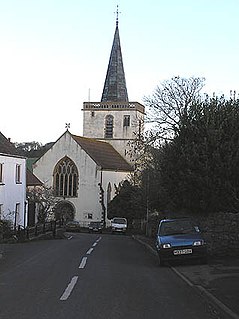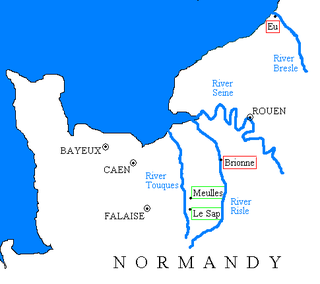Related Research Articles

Stogursey is the name of a small village and civil parish in the Quantock Hills in Somerset, England. It is situated 3 miles (4.8 km) from Nether Stowey, and 8 miles (12.9 km) west of Bridgwater. The village is situated near the Bristol Channel, which bounds the parish on the north.
Robert fitz Martin was a Norman knight from Devon whose father, Martin de Turribus, was the first Norman Lord of Kemes, in what had previously been the Dyfed part of Deheubarth.

Baldwin FitzGilbert was a Norman magnate and one of the 52 Devon Domesday Book tenants-in-chief of King William the Conqueror, of whom he held the largest fiefdom in Devon, comprising 176 holdings or manors. He was feudal baron of Okehampton, seated at Okehampton Castle in Devon.
Richard de Courcy was a Norman nobleman and landholder in England.

The Priory of St. Andrews of the Ards (Blackabbey) was a Benedictine Abbey at Stogursey in Somerset.
Roger d'Abetot was a medieval English Sheriff of Worcestershire.
William de Falaise, also called William of Falaise, was a Norman from Falaise, Duchy of Normandy, today in the Calvados department in the Lower Normandy region of north-western France. He became feudal baron of Stogursey in Somerset and also held manors in Devon.
Hugh de Cressy was an Anglo-Norman administrator and nobleman. Little is known of his ancestry and he first served two brothers of King Henry II of England before becoming a royal official. He was rewarded with a marriage to an heiress for his service to the king. In England he often served as a royal justice and witnessed documents, which showed his closeness to the king. On the continent, he recruited mercenaries for the royal army and was named constable of the castle of Rouen in the royal lands in France. He died in 1189 after giving lands to various monasteries before his death.
William de Courcy was an Anglo-Norman nobleman and baron.
William de Courcy was an Anglo-Norman nobleman and baron.
William Meschin was an Anglo-Norman nobleman and baron. The brother of the earl of Chester, Meschin participated in the First Crusade. After returning to England, he acquired lands both from King Henry I of England and by his marriage to an heiress.
Robert fitzRoger, Lord of Warkworth, Clavering and Eure, was an Anglo-Norman nobleman and Sheriff of Norfolk and Suffolk and Northumberland. He was a son of Roger fitzRichard and Adelisa de Vere. FitzRoger founded the monastery of Langley, Norfolk in 1195.
William Paynel was an Anglo-Norman nobleman and baron.

The feudal barony of Okehampton was a very large feudal barony, the largest mediaeval fiefdom in the county of Devon, England, whose caput was Okehampton Castle and manor. It was one of eight feudal baronies in Devonshire which existed during the mediaeval era.
William Pantulf was an Anglo-Norman nobleman and Baron of Wem. He was born in Hiémois, a county of Normandy, where his family had lived since around 1030. Pantulf held lands in Shropshire following the Norman Conquest of England. A vassal of Roger of Montgomery, the Earl of Shrewsbury, Pantulf was accused of murdering Roger's wife but proved his innocence of the charge by a trial by ordeal. When Roger's son Robert of Belleme rebelled against King Henry I of England, Pantulf did not take part and sided with the king. Upon his death, which most likely occurred in 1112, William's eldest son Philip inherited his Norman lands, and his second son Robert received the English lands.
Adam de Port was an Anglo-Norman nobleman and Baron of Kington.
Manasser Biset was an Anglo-Norman nobleman and royal official during the reign of King Henry II of England.
Hugh de Beauchamp was a Norman who held lands in England after the Norman Conquest.
Robert de Todeni was a Norman nobleman who held lands in England after the Norman Conquest.
Sibyl of Falaise was an Anglo-Norman noblewoman and kinswoman of King Henry I of England.
References
- Farrer, William. Honors and Knights' Fees: Volume 1.
- Green, Judith A. (1986). The Government of England Under Henry I. Cambridge: Cambridge University Press. ISBN 0-521-37586-X.
- Green, Judith A. (2006). Henry I: King of England and Duke of Normandy. Cambridge: Cambridge University Press. ISBN 978-0-521-74452-2.
- Keats-Rohan, K. S. B. (1999). Domesday Descendants: A Prosopography of Persons Occurring in English Documents, 1066–1166: Pipe Rolls to Cartae Baronum. Ipswich, UK: Boydell Press. ISBN 0-85115-863-3.
- Lobel, Mary D., ed. (1957). "Parishes: Nuneham Courtenay". A History of the County of Oxford: Volume 5: Bullingdon hundred. Victoria County History. Victoria County History. pp. 234–249. Retrieved 9 July 2013.
- Loyd, Lewis Christopher (1975) [1951]. The Origins of Some Anglo-Norman Families (Reprint ed.). Baltimore, MD: Genealogical Publishing Company. ISBN 0-8063-0649-1.
- Newman, Charlotte A. (1988). The Anglo-Norman Nobility in the Reign of Henry I: The Second Generation. Philadelphia: University of Pennsylvania Press. ISBN 0-8122-8138-1.
- Sanders, I. J. (1960). English Baronies: A Study of Their Origin and Descent 1086–1327. Oxford, UK: Clarendon Press. OCLC 931660.